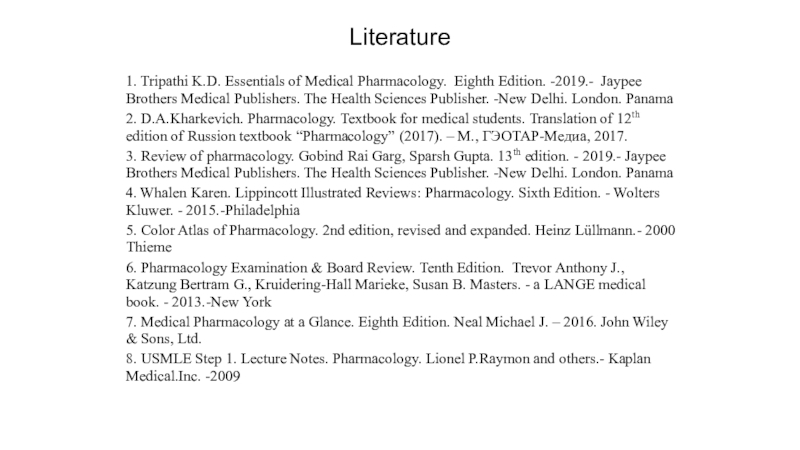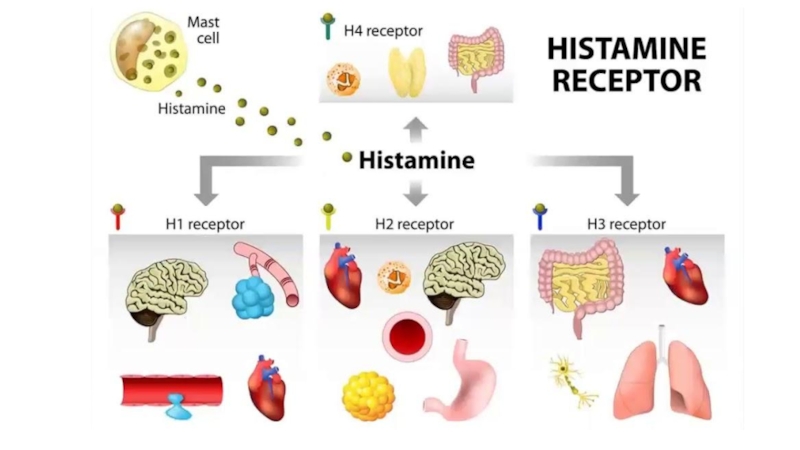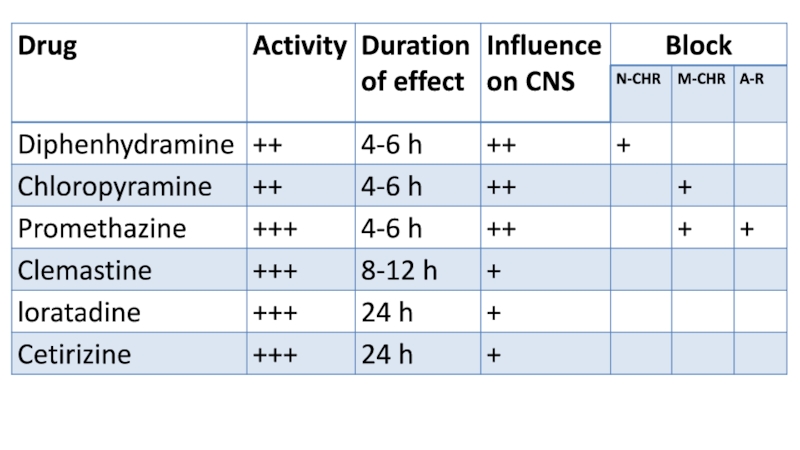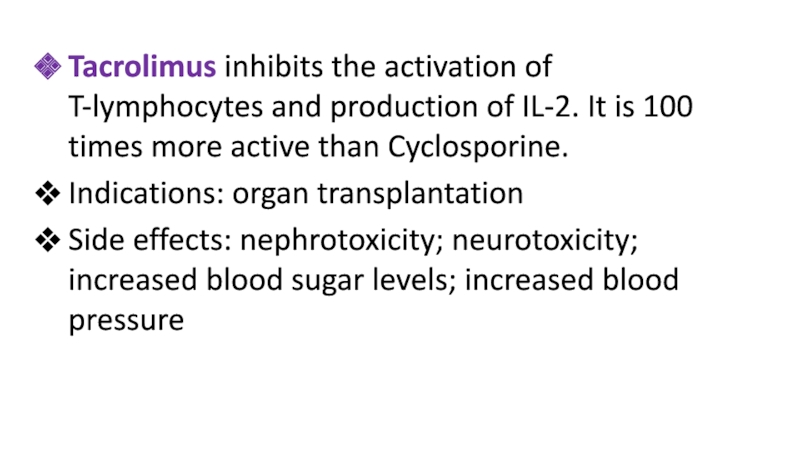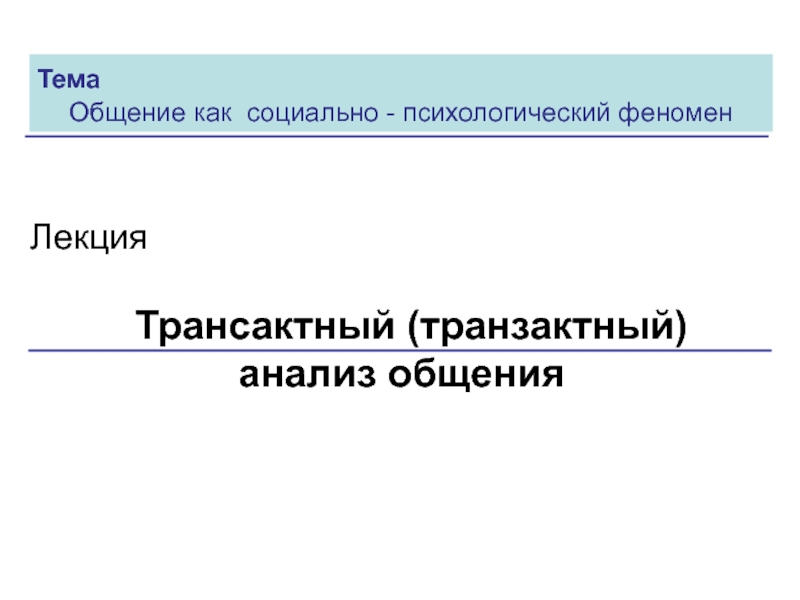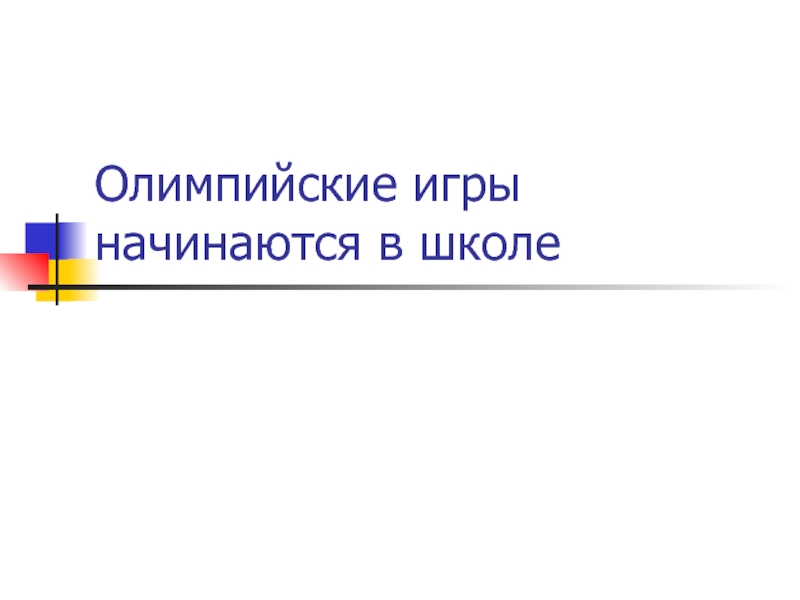Слайд 1Drugs affecting the immune system
Antiallergic drugs, immunosuppressants
Immunostimulators
Слайд 2 Pathologically excessive immune responses to an antigen that cause damage
to the tissue of a sensitized macroorganism are called allergic
(hypersensitivity) reactions. Such reactions are relatively common.
There are 2 main mechanism of immunogenesis:
Humoral, that occurs due to antibody production;
Cellular one that involves many immunocompetent cells.
Hypersensitivity reactions can be divided into the following types: immediate types and delayed type of hypersensitivity.
Слайд 5 Immediate type of hypersensitivity (allergy) is manifestered minutes or hours
after subsequent exposure to the antigen. It occurs due to
the interaction between antigens and antibodies. Antibodies are produced by plasmocytes. They are fixed on the high-affinity receptors on the cells (mast cells, basophils). Interaction between an allergen and antibodies leads to tissue damage. Biologically active substances release from cells.
Among reactions of immediate type there are allergic bronchospasm, rhinitis, conjunctivitis, urticaria, anaphylaxis, drug-dependent thrombocytopenic purpura, serum sickness, Arthus’s phenomenon and others.
Слайд 6Anaphylactic reactions are the most dangerous.
The interaction of
the Antigen with 2 JgЕ on the surface of the
mast cell or basophile is accompanied by:
The opening of Ca-channels and entry of Ca++ into the cell;
Activation of phospholipase A2 with increasing of membrane permeability and formation of prostaglandins and leukotrienes;
Degranulation of mast cells (basophils), release of mediators of allergy (histamine, serotonin, bradykinin) into the surrounding tissue;
Tissue damage, development of swelling, bronchospasm, collapse, skin rashes, itching, etc.
Слайд 8 Delayed type of hypersensitivity becomes apparent after 2-3 days and
later. It is the result of cell immunity and depends
on the presence of sensitizing T-lymphocytes. On the surface of such T-L there are special receptors which recognize antigens, localized on macrophages, and interact with them. Cytokines release from T-L and damage cells.
Tuberculin reactions, contact dermatitis, graft-versus-host reaction and some types of immune pathology are the result of delayed type of hypersensitivity.
Слайд 9Treatment of allergic disease should be started with specifying the
origin of the allergen (plant pollen, medical drugs, certain food
products, animal hair). Avoidance of contact with allergen produces the best result.
Specific hyposensitization may be used. Low doses of the identified allergen are introduced and this decreases the specific sensitivity.
Non-specific hyposensitization may be used if antigen is unknown.
Слайд 10Histamine is one of the main mediators of allergic reactions.
He stimulates 4 main types of histamine receptors.
Слайд 14Classification of anti-allergic drugs
Drugs that prevent the formation and release
of histamine and other mediators from sensitized mast cells and
basophils:
Adrenergic agonists (epinephrine, salbutamol, fenoterol);
Dimethylxanthine (aminophylline);
M-blockers (ipratropium bromide)
Specific stabilizers of membranes of mast cells (cromoglicici acid, ketotifen);
Glucocorticoids (Prednisolone, Dexamethasone, Beclomethasone)
Слайд 152.Drugs reducing the interaction of biologically active substances (mediators of
allergy) with the tissue receptors:
blockers H1-histamine receptors (diphenhydramine, etc.);
blockers
of LT-receptors (montelucast)
3. Drugs eliminating the symptoms of allergic reactions:
anaphylactic shock - epinephrine, phenylephrine, prednisolone
bronchospasm – salbutamol, fenoterol, aminophylline, ipratropium bromide
4. Drugs reducing inflammation and tissue damage – NSAIDs and SAIDS
Слайд 17Mechanism of anti-allergic action of β-adrenoceptors agonists:
They stimulate
β2-AR on the membrane of mast cells and increase activity
of adenylyl cyclase
→increase in cAMP levels
→closing of the Ca channels→ decrease in the number of active Ca in the cell
→inhibition of degranulation of mast cells
→decrease in the release of mediators of Allergy
Слайд 18Salbutamol and fenoterol expand bronchi and help expectorate sputum. They
are administered via inhalers for the relief of bronchospasm (effect
in 2-3 min.). Salmeterol, Formoterol are used orally or via inhalers in order to prevent bronchospasm.
Epinephrine is also used in a case of bronchospasm. It stimulates α-AR and increase blood pressure. Epinephrine is used for relief of anaphylactic shock.
Слайд 20Methylxanthines (aminophylline, theophylline) block adenosine receptors on the membrane of
mast cells, inhibit IgE landing on mast cells. They increase
the catecholamines‘ levels and reduce the process of degranulation.
They inhibit phosphodiesterase and increased cAMP level, reduce level of Ca and decrease the process of degranulation.
They also increase the level of T-suppressors and decrease excessive allergic reaction. They have myotropic bronchodilator effect.
Indications for use: -relief of an attack of BA (IV) - prevention of bronchial spasm (tabl.)
Слайд 22Cromoglicici acid (Sodium cromoglycate):
1.Blocks chloride channels in the membrane
of the mast cells→ closing the Ca channels→ Stabilization of
the membranes of mast cells and granules, ↓degranulation.
2. ↓ release of mediators of allergy (histamine, SRS-A).
3. Increases the sensitivity of β2-AR to catecholamines
4. Reduces the need for inhaled corticosteroids.
Слайд 23It is used for the prophylaxis bronchial asthma attacks. The
drug is administered via inhaler.
The onset of action develops
after 2 weeks Pronounced effect develops within 4-5 weeks.
It is poorly soluble in water, it is not absorbed in the digestive tract. It can be used for prevention allergic rhinitis (drops) and food allergic reactions.
Слайд 24Ketotifen is known to inhibit release of allergic mediators from
mast cells. It also blocks H1-histamine receptors. It decreases the
formation of IgE.
K. is administered orally for the prevention of bronchial asthma attacks, hay asthma, rhinitis and other allergic reactions of the immediate type. The drug acts slowly and reaches its maximum effect in 3-4 weeks.
The adverse effects: sedation, thrombocytopenia.
Слайд 26Glucocorticoids reduce the formation of IgE (reduce the sensitization of
the body).
They block phospholipase A2, inhibit degranulation and release
of histamine, serotonin and other allergy mediators, reduce the formation of leukotrienes. They reduce the synthesis of histamine, reduce the sensitivity of histamine receptors, increases the metabolism of histamine (promotes the synthesis of histaminase in the liver).
They eliminate such manifestations of allergy symptoms as a decreasing of blood pressure and bronchospasm (symptomatic effect).
Glucocorticoids are used in all allergic reactions of immediate type.
Слайд 27Glucocorticoids:
A. Systemic: hydrocortisone, prednisolone , dexamethasone, triamcinolone
B. Inhalational: beclomethasone
dipropionate,
budesonide, fluticasone propionate
Слайд 28Montelukast blocks leukotriene receptors and causes anti-inflammatory effect. Such effect
manifests as a reduction of vascular permeability, a decrease in
the mucosal edema of the bronchi, suppression of the secretion of viscous sputum. Bronchodilation occurs due to the blockade of LTD4-R.
It is used orally. Its clinical effect develops slowly (over 24 h). It is used for the prophylaxis of bronchial asthma.
Adverse effects: headache, gastritis, skin allergies, myalgia.
Слайд 29Antihistamines (blockers of histamine H1-R) block tissue receptors sensitive to
histamine. They do not really affect the release of free
histamine or histamine synthesis.
They remove such effects of H. as increase in smooth muscle tone of bronchi, intestine, uterus; decrease in blood pressure, increase in capillary permeability followed by edema; hyperemia and pruritis.
Слайд 30Classification
1 generation: diphenhydramine, promethazine pheniramine, chloropyramine, clemastine,
quifenadin, mebhydrolin
2 generation: loratadine, astemizole, cetirizine.
3 generation
(active metabolites of the 2nd ): desloratadine, fexofenadine, levocetirizine, ebastine.
Слайд 31Indications for use
Urticaria
Hay asthma
Allergic rhinitis and conjunctivitis
Angioneurotic edema
Drug allergy
Food allergy
Drugs
for relief of anaphylactic shock: epinephrine, prednisone, diphenhydramine.
Слайд 32Comparative characteristics of the H1-blockers
The drugs of 1-generation are dissolved
in fats, pass through the BBB, have central effects. Their
action begins during 20-60 minutes, duration of action is on average 4-6 hours (clemastin -12 hours). They are administered orally and parenterally.
But! mebhydrolin does not pass through the BBB, does not have a sedative effect. It acts 24-48 hours.
Слайд 33Drugs of the 2nd generation poorly pass through the BBB
and do not have a sedative effect.
They are prescribed orally,
the action begins in 1-2 hours, lasts 20-24 hours (astemizol-48 hours).
They're cardiotoxic.
Some drugs of the 3rd generation are the active metabolites of the drugs of the 2nd generation. Their effect does not depend on metabolism.
Слайд 35The effect on the Central nervous system:
Sedative
Hypnotic
Potentiating
Antiemetic
Indications:
insomnia;
premedication
before anesthesia;
fever with antipyretics;
vestibular disorders (motion sickness)
Слайд 36Possible adverse effects
The first generation drugs cause drowsiness, lethargy, confusion,
decrease in speed of psychomotor reactions, discoordination of movements
Diphenhydramine can
cause excitement (in children and the elderly even in a therapeutic dose)
Headache, dizziness, dry mouth (M-blocking effect of promethazine and chloropyramine)
Increase of appetite, increase in the body weight
A decrease in the efficiency of the drugs of I generation
Слайд 37Drugs for the treatment of reactions
of delayed type of
hypesensitivity
Drugs suppressing immunegenesis (Immunosuppressants):
Glucocorticoids (prednisolone, etc.)
Cytotoxic agents
(azathioprine, 6-mercaptopurine, cyclophosphamide,)
Antibiotics (cyclosporine, tacrolimus)
2. Drugs diminishing tissue damage: SAID, NSAID
Слайд 39 Immunosupressing action of glucocorticoids results from the inhibition of lymphocyte
proliferation (especially T-L). Antigen recognition is also suppressed. Activity of
macrophages is decreased. The production and activity of interferon and a number of interleukins are reduced. Cytotoxicity of some T-L population (T-K) is decreased. The formation of migration inhibitory factors is suppressed. Large doses provide lowing of specific antibody production and anti-body complex formation. Glucocorticoids have anti-inflammatory effect also. They are used for the treatment of collagenosises.
Слайд 40Cytostatics inhibit cell division of lymphoid tissue, reduce the formation
and activity of immune cells, inhibit the immunopathological mechanisms for
the development of connective tissue.
Indications: rheumatoid arthritis; lupus erythematosus and other diseases of connective tissue (reserve drugs).
Complications: hematotoxicity, hepatotoxicity, nephrotoxicity, teratogenicity.
Слайд 41Azathioprine is an antimetabolite that is converted into 6-mercaptopurine and
disrupts the metabolism of purines. It inhibits the proliferation of
tumor cells.
It has an immunosuppressive effect in low doses, inhibits the proliferation of t-lymphocytes and their activity.
Indications: Autoimmune diseases, organ transplantation (reserve medicine).
Side effects: inhibition of bone marrow function, leucopenia, anemia, thrombocytopenia, excessive bleeding, nausea, vomiting, diarrhea, jaundice.
Слайд 42Cyclosporine inhibits macrophages and reduces the production of IL-1. It
reduces the differentiation and activity of T-lymphocytes, inhibits the activity
of T-helpers, but keeps the activity of T-suppressors, promotes natural immunosuppression. It suppresses the rejection of transplanted tissues and organs. The drug reduces production of IL-2 and gamma interferon.
Indications: Organ transplantation; autoimmune diseases (rarely)
Side effects: Hepato-and nephrotoxicity.
Слайд 43Tacrolimus inhibits the activation of T-lymphocytes and production of IL-2.
It is 100 times more active than Cyclosporine.
Indications: organ transplantation
Side
effects: nephrotoxicity; neurotoxicity; increased blood sugar levels; increased blood pressure
Слайд 45Immunostimulants
Natural:
Vaccines, preparations of bacterial lysates (Imudon),
Preparations of thymus: Timalin,
Taktivin
Preparations of interferons (α,β,γ),
Adaptogens: Immunal (preparation of Echinacea), preparations of
Chinese Magnolia vine, Ginseng
Synthetic drugs: Levamizol, Dibazol, Methyluracil, Azoximer bromide (Polyoxidonium)
Слайд 46Preparations of Chinese Magnolia vine, Echinacea, Ginseng, Siberian Ginseng
Слайд 47Mechanisms of action of immunostimulants
Immunomodulators stimulate non-specific immunity: Increase
activity of immunocompetent cells (T-and B-lymphocytes and macrophages); production of
cytokines, antibody formation.
They stimulate non-specific immunity: increase the production of interferon, lysozyme, phagocytosis completeness, complement system activity.
Слайд 48Indications for use
Chronic purulent infections
Malignant neoplasms
Radiation sickness
Chemotherapy and radiation
therapy
Leukopenia
Poorly healing wounds and ulcers
Immunodeficiency after the use of antibiotics,
glucocorticoids
Слайд 49Thymus preparations
Activate the system of T-lymphocytes,
Normalize the ratio
of T-and b-lymphocytes,
Normalize the reaction of cellular immunity,
Increase
phagocytosis
Stimulate the production of lymphokines.
Слайд 50Literature
1. Tripathi K.D. Essentials of Medical Pharmacology. Eighth Edition. -2019.-
Jaypee Brothers Medical Publishers. The Health Sciences Publisher. -New Delhi.
London. Panama
2. D.A.Kharkevich. Pharmacology. Textbook for medical students. Translation of 12th edition of Russion textbook “Pharmacology” (2017). – М., ГЭОТАР-Медиа, 2017.
3. Review of pharmacology. Gobind Rai Garg, Sparsh Gupta. 13th edition. - 2019.- Jaypee Brothers Medical Publishers. The Health Sciences Publisher. -New Delhi. London. Panama
4. Whalen Karen. Lippincott Illustrated Reviews: Pharmacology. Sixth Edition. - Wolters Kluwer. - 2015.-Philadelphia
5. Color Atlas of Pharmacology. 2nd edition, revised and expanded. Heinz Lüllmann.- 2000 Thieme
6. Pharmacology Examination & Board Review. Tenth Edition. Trevor Anthony J., Katzung Bertram G., Kruidering-Hall Marieke, Susan B. Masters. - a LANGE medical book. - 2013.-New York
7. Medical Pharmacology at a Glance. Eighth Edition. Neal Michael J. – 2016. John Wiley & Sons, Ltd.
8. USMLE Step 1. Lecture Notes. Pharmacology. Lionel P.Raymon and others.- Kaplan Medical.Inc. -2009
